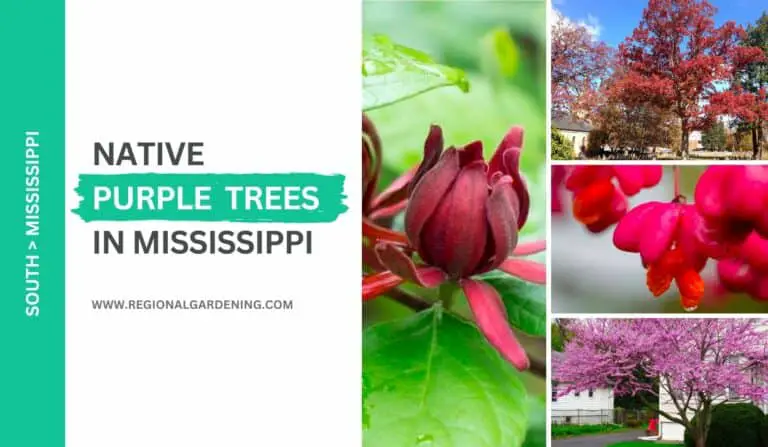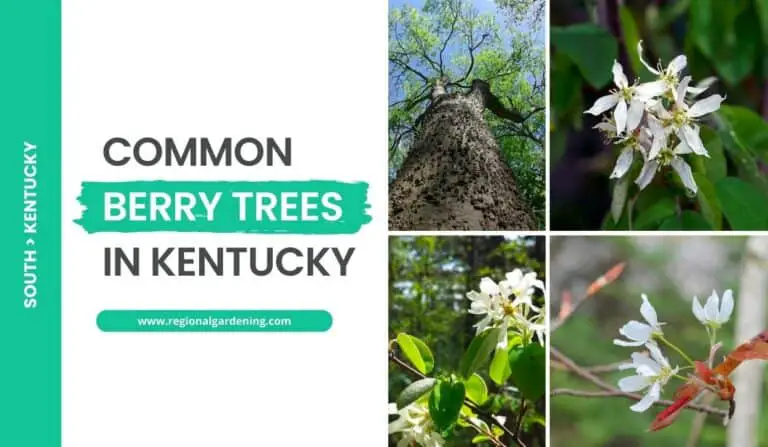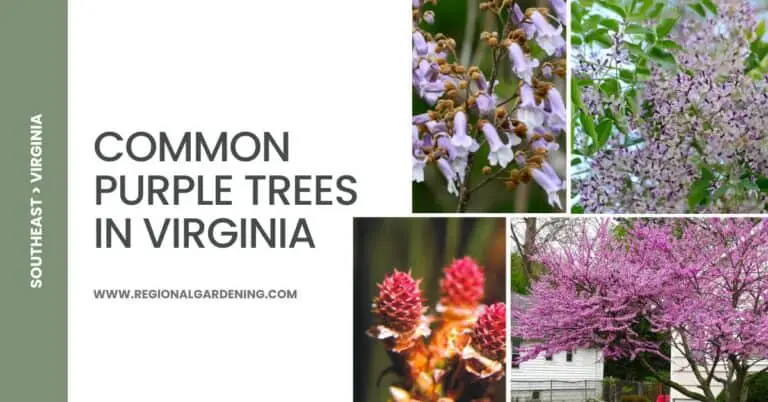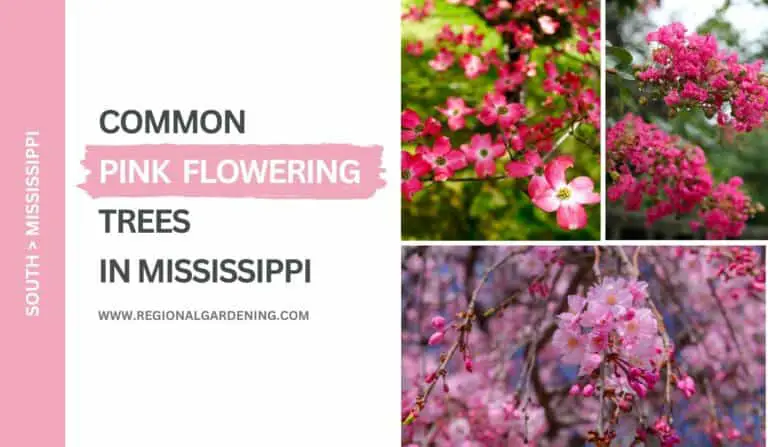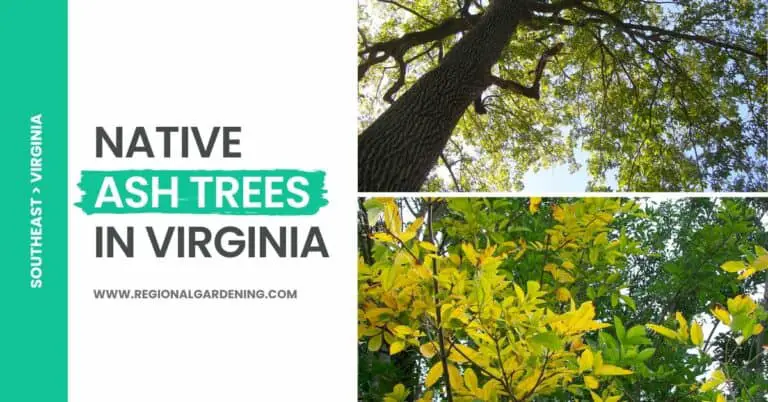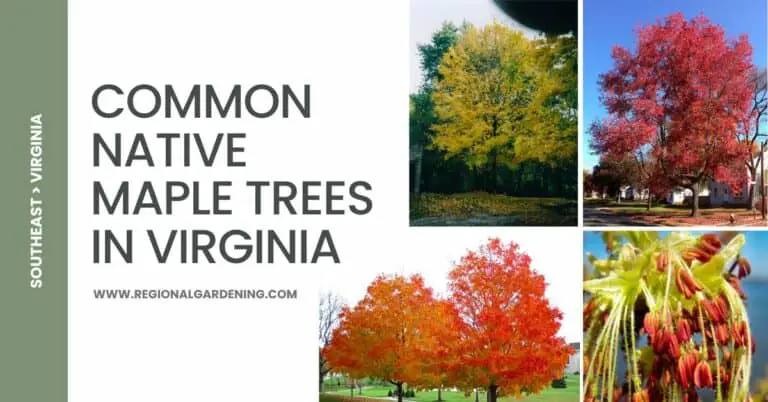6 Common Palm Trees In Oklahoma (Photos & Identification)
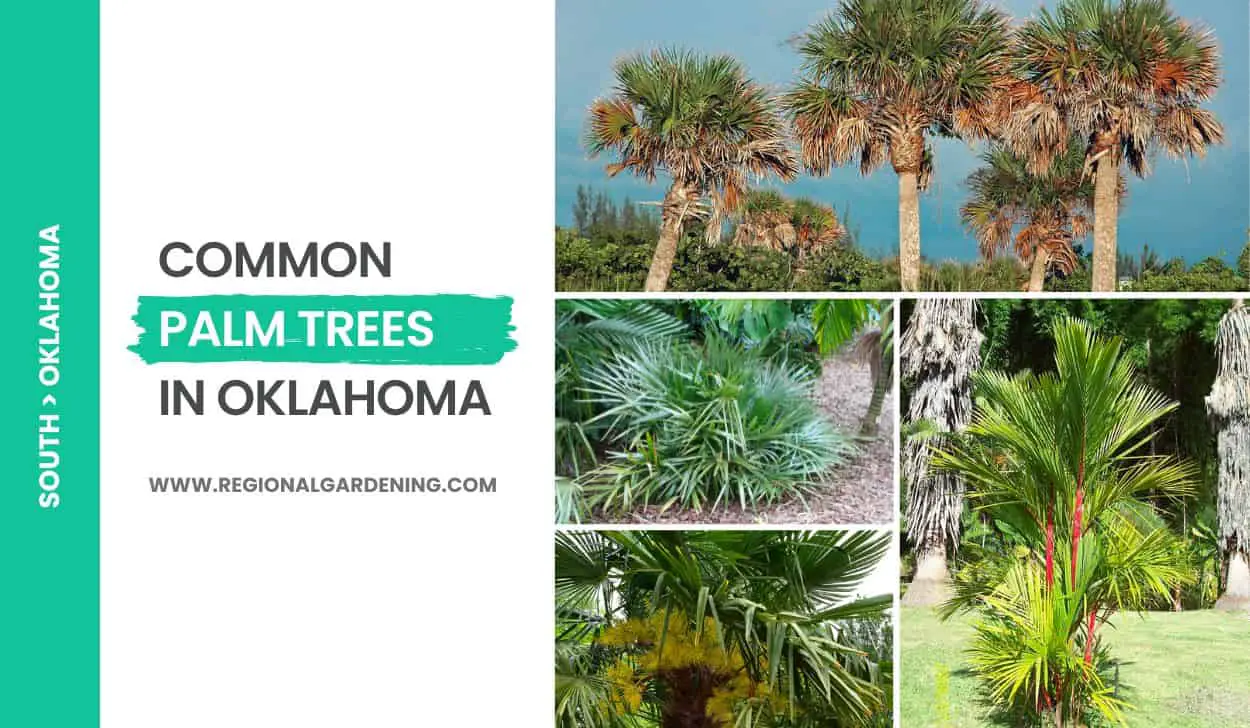
The picturesque sight of lush palm trees may not immediately come to mind when one thinks of Oklahoma.
Nevertheless, despite all odds, these graceful trees have settled among the Sooner State’s plains and prairies, adding a touch of the tropics to its landscapes. Although they are not native to Oklahoma, palm trees are a preferred option for homeowners and landscapers looking to give their surroundings a touch of exotic beauty.
And in this article, we will examine the six most common palm trees in Oklahoma, complete with high-quality images and a detailed description.
1. Windmill Palm
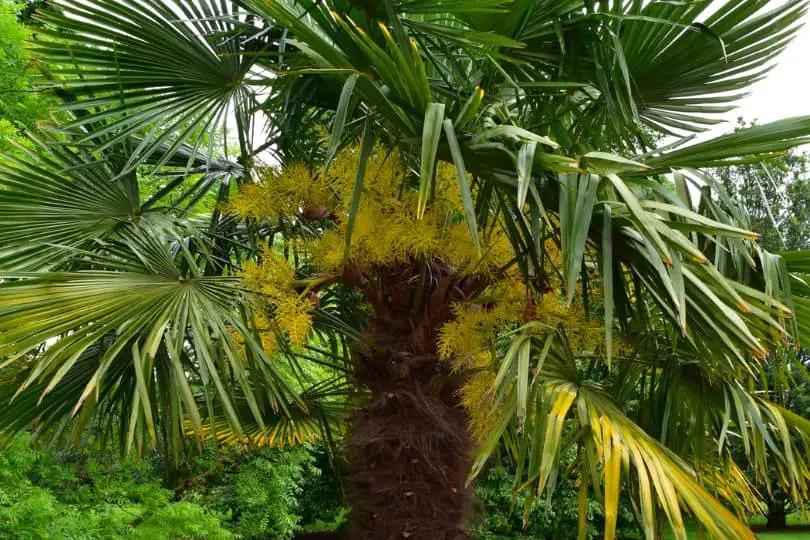
- Scientific Name: Trachycarpus fortunei
- Common Name(s): Windmill Palm, Chusan Palm
- Mature Height: 20-40 feet (6-12 meters)
- Native Region: East Asia
- Flowers: Small yellow flowers arranged in large clusters, appearing in late spring or early summer.
- Fruit: Small black berries
- Uses: Ornamental landscaping, adds a tropical look to gardens or landscapes.
Because of its cold tolerance and unusual appearance, the Windmill Palm, also known as Trachycarpus fortunei or Chusan Palm, is a popular choice for landscaping in Oklahoma. It is native to East Asia and can grow to be 20-40 feet (6-12 meters) tall when mature.
The slender trunk of this palm tree is covered in a fibrous brown mat, which adds to its allure. Windmill Palm gets its name from its huge, fan-shaped, deeply divided leaves, which resemble a windmill. These leaves have a brilliant green color and can grow to be three feet long.
The Windmill Palm produces little yellow blooms in big clusters in late spring or early summer, lending a beautiful touch to the tree. Small black berries appear after the blossoms, giving aesthetic appeal.
Windmill Palm Care in Oklahoma entails growing it in well-drained soil in a position with full to partial sun. This palm is quite durable and can withstand Oklahoma’s frigid winters, but it may benefit from winter protection during extreme cold spells.
This tree requires regular watering, especially during the summer months when the soil can dry out quickly. In the spring and summer, a slow-release palm fertilizer can support healthy development.
Windmill Palms are frequently utilized as ornamentals in gardens, parks, and landscapes. Their exotic appearance gives any setting a tropical flair. Despite being palm, they require little care and may thrive in a variety of soil types and circumstances.
They also make great container plants for patios or other small areas.
The Windmill Palm, whether as a single specimen or in a grouping, adds a touch of grace and beauty to Oklahoma settings.
2. Needle Palm
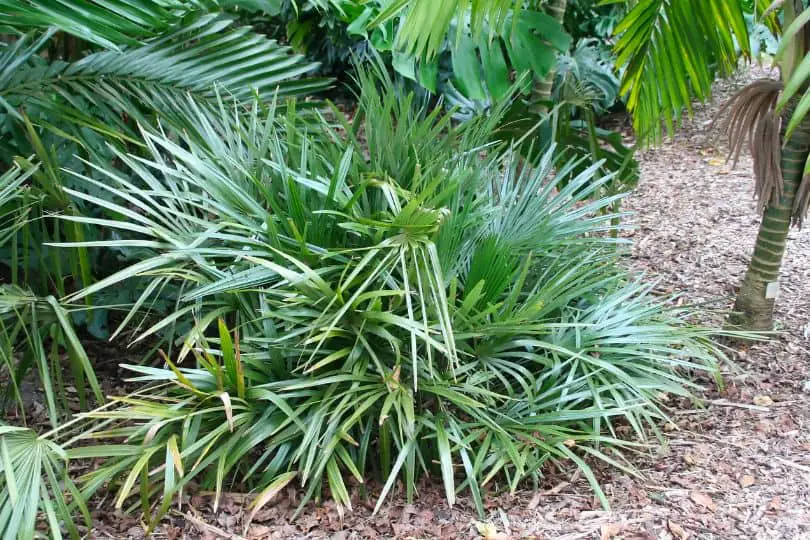
- Scientific Name: Rhapidophyllum hystrix
- Common Name(s): Needle Palm, Porcupine Palm
- Mature Height: 4-10 feet (1.2-3 meters)
- Native Region: Southeastern United States
- Flowers: Small, yellow to brown flowers in clusters
- Fruit: Dark brown to black, oval-shaped fruits
- Uses: Popular for landscaping in dry and sandy areas, can tolerate cold temperatures well, and is often used as an accent plant or for creating a tropical atmosphere in gardens or patios.
The Needle Palm, also known as the Porcupine Palm, is a small, slow-growing palm tree native to the United States southeastern states. It can mature to a height of 4 to 10 feet (1.2 to 3 meters) and is recognized for its tough appearance and capacity to withstand hard environments.
This palm tree has strong, fan-shaped leaves that are deep green in color and sharp, needle-like spines along the leaf stems, hence the name “Needle Palm.” These spines give the tree a distinct and unique appearance. The Needle Palm’s trunk is often short and low to the ground, resulting in a compact and bushy growth habit.
The Needle Palm is typically found in sandy coastal areas and pine woods in its native range. It thrives in well-drained soil and, once established, can withstand drought conditions. It is a good choice for gardeners looking for a low-maintenance and robust plant in Oklahoma landscapes.
The Needle Palm produces little clusters of yellow to brown blooms in late spring or early summer, which are not extremely spectacular but provide interest to the tree. Following the blossoms, oval-shaped dark brown to black fruits form, which provide food for wildlife.
When growing Needle Palms in Oklahoma, it is critical to select a planting place that provides full sun to partial shade. The soil should be well-drained and organically rich. Water the palm regularly during the first few months after planting to help it establish, then reduce watering to match its native drought-tolerant conditions.
The Needle Palm is a fantastic addition to any Oklahoma landscape since it offers a hint of the tropics while withstanding the state’s varied weather conditions. It is suitable for use as an accent plant, in containers, or in groups to produce a dense and luxuriant appearance.
The Needle Palm is an excellent choice for gardeners looking for a distinctive and robust palm tree due to its durability and low maintenance requirements.
3. Sabal Palmetto
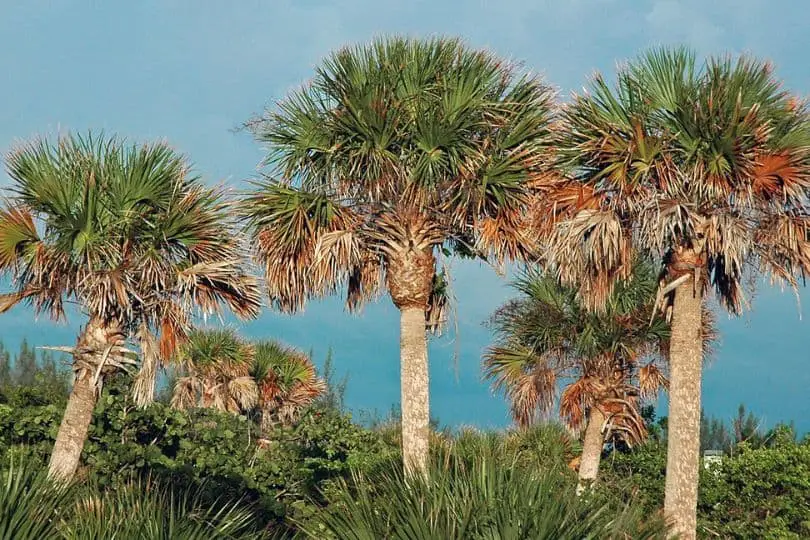
- Scientific Name: Sabal palmetto
- Common Name(s): Palmetto, Cabbage Palm
- Mature Height: 30-80 feet (9-24 meters)
- Native Region: Southeastern United States, including Oklahoma
- Flowers: Pale yellow to white flowers in clusters
- Fruit: Small, black, shiny fruits
- Uses: Ornamental tree, shade tree, source of food and shelter for wildlife, fiber for hats and baskets
The Sabal palmetto, also known as the Palmetto or Cabbage Palm, is a tall, single-trunked tree that can grow to be 30 to 80 feet (9 to 24 meters) tall. It is found throughout the southeastern United States, including sections of Oklahoma. Because of its unusual and appealing appearance, the tree is a popular choice for landscaping.
The Palmetto has long, fan-shaped, bright green leaves that can grow up to 5 feet (1.5 meters) in length. These leaves are linked to a strong trunk with fibrous, rough bark. The trunk of the tree is normally straight, but it can become rather thick with age. It’s no surprise that the Sabal palmetto is also known as the “Cabbage Palm” due to its resemblance to the cabbage plant.
During the spring, the Sabal palmetto develops clusters of small, pale yellow to white nectar-rich blooms. Pollinators such as bees, butterflies, and birds are drawn to these blooms. A variety of animal species, including birds and small mammals, enjoy the tree’s small, black, lustrous fruits that it produces in the late summer.
The Sabal palmetto can be used as an attractive tree in Oklahoma settings, adding a tropical flair to gardens. Its tall stature and dense leaves make it a great shade tree in the summer, providing relief from the hot heat. Furthermore, the tree’s abundant blossoms and fruits attract beneficial species, making it an excellent choice for developing wildlife-friendly landscapes.
To properly care for the Sabal palmetto in Oklahoma, it must be planted in well-drained soil with full sunlight. This tree is quite adaptable and can grow in a variety of soil types, including sandy and clay soils.
Watering is required regularly during the establishment stage, but once established, the Palmetto is drought-tolerant. Pruning should be kept to a minimum, with only dead or damaged fronds removed.
4. Pindo Palm
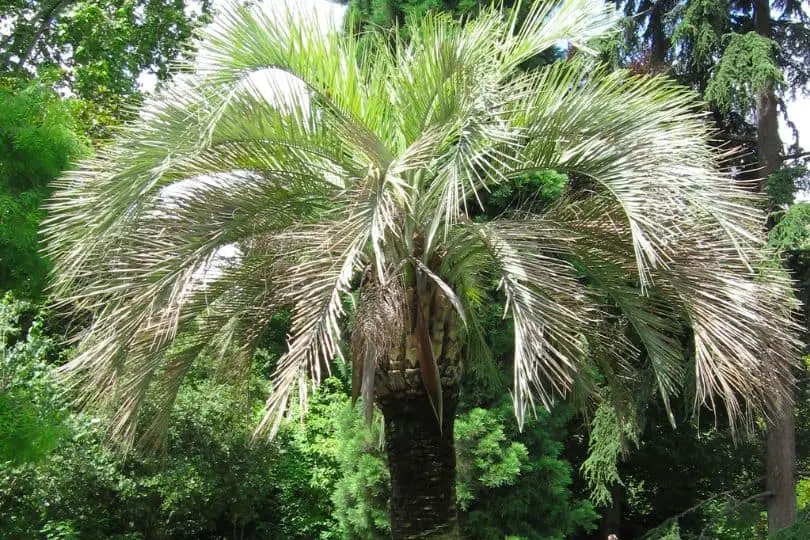
- Scientific Name: Butia capitata
- Common Name(s): Pindo Palm, Jelly Palm
- Mature Height: 10-20 feet (3-6 meters)
- Native Region: South America
- Flowers: Orange-yellow flowers in summer
- Fruit: Yellow to orange fruit, similar to small coconuts
- Uses: Pindo Palms are commonly used as ornamental trees and add a tropical touch to landscapes. The fruit can be used to make jelly and wine.
The Pindo Palm, also known as Butia capitata or Jelly Palm, is a medium-sized tree that grows to be 10-20 feet (3-6 meters) tall when mature. This palm species is native to South America and has become a popular choice for landscaping in Oklahoma.
The Pindo Palm stands out for having fluffy, blue-green leaves that gently arch from the tree’s top. The trunk is coated in persistent leaf bases, giving the tree a distinct texture. The Pindo Palm produces clusters of orange-yellow flowers in the summer, bringing a dash of color to the landscape. These blossoms give place to yellow to orange fruit that resembles miniature coconuts.
The Pindo Palm thrives in sandy coastal plains in its natural range and can endure poor soils and salt spray. It thrives in well-drained soils and prefers full sun exposure in Oklahoma. Once established, it is a low-maintenance tree that can endure drought conditions.
The Pindo Palm is valued not just for its beauty qualities, but also for its functional use. The Pindo Palm fruit is edible and can be used to make excellent jelly and even homemade wine.
The tree’s adaptability and tolerance to a variety of soil conditions make it an excellent choice for landscaping in Oklahoma, adding a tropical touch to the local environment. The Pindo Palm is a versatile addition to any landscape, with its gorgeous leaves, vivid flowers, and valuable fruit.
5. European Fan Palm
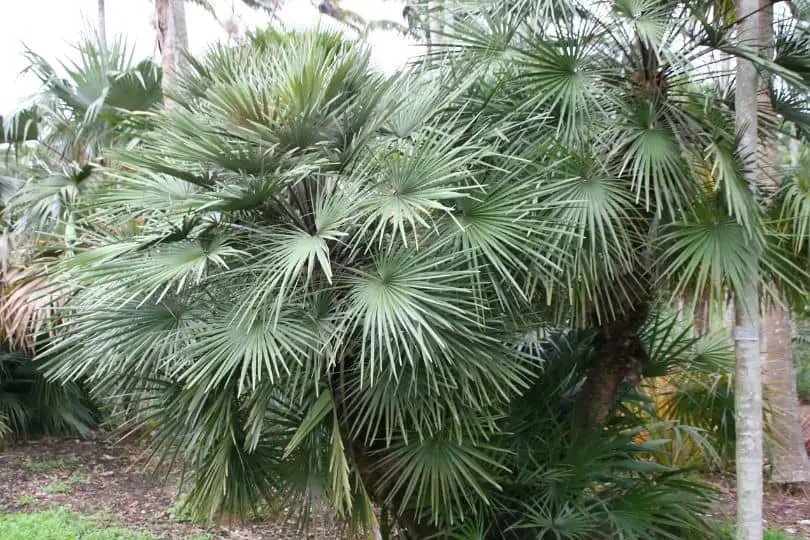
- Scientific Name: Chamaerops humilis
- Common Name(s): European Fan Palm
- Mature Height: 6-10 feet (1.8-3 meters)
- Native Region: Mediterranean region
- Flowers: Small yellow flowers in dense clusters
- Fruit: Small, rounded blackberries
- Uses: Ornamental plant, commonly used as a landscaping feature in gardens, parks, and urban landscapes.
Because of its distinct and appealing appearance, the European Fan Palm, scientifically known as Chamaerops humilis, is a popular choice for landscaping in Oklahoma. This palm tree is endemic to the Mediterranean region, where it thrives in hot, dry conditions.
It is a slow-growing palm with a mature height of 6-10 feet (1.8-3 meters), making it a good choice for smaller landscapes.
The European Fan Palm grows in dense bunches of fan-shaped leaves and has a compact growth habit. The leaves have a deep green color with hard, serrated edges, giving it an exotic and tropical appearance.
Small yellow blooms appear in thick clusters in the spring, bringing a splash of color to the environment. These flowers are followed by little, spherical blackberries that are not edible.
The European Fan Palm thrives on well-drained soil with full sun exposure in Oklahoma landscapes. It can grow in a variety of soil types, from sandy to clay, as long as they are well-drained.
Maintenance is necessary during the establishing period, but once established, it is drought-tolerant and requires little maintenance. It is also cold resistant, withstanding temperatures as low as 10°F (-12°C) with suitable protection.
In Oklahoma, the European Fan Palm is mostly used as a decorative plant. Its distinctive shape and small size make it a fantastic choice for bringing a tropical flavor to gardens, parks, and urban spaces.
It can be planted as a single specimen or in groups to create a visually appealing focal point. It is a popular choice for both novice and professional gardeners due to its low maintenance requirements, which include little to no trimming or fertilizer.
6. Umbrella Palm
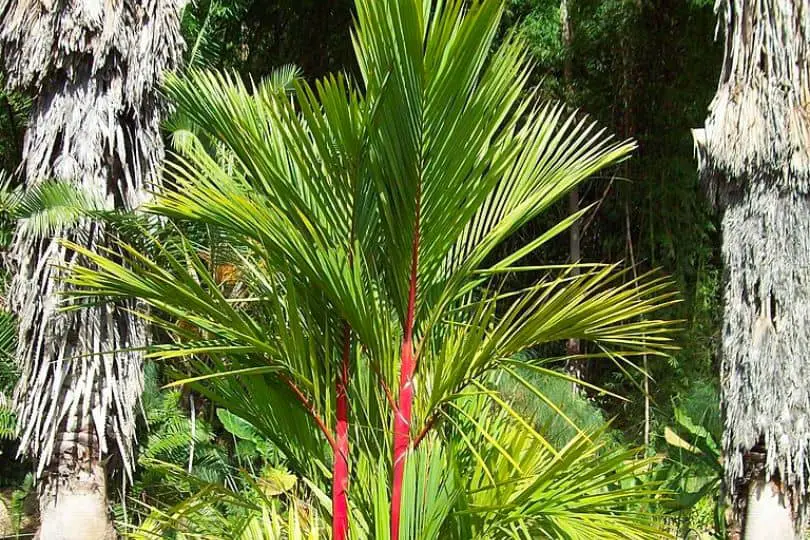
- Scientific Name: Cyrtostachys renda
- Common Name(s): Umbrella Palm, Sealing wax palm
- Mature Height: 6-10 feet (1.8-3 meters)
- Native Region: Southeast Asia
- Flowers: No Flowers
- Uses: Ornamental landscaping, indoor plant
The Umbrella Palm, also known as Cyrtostachys renda or Sealing wax palm, is a beautiful tropical tree that would complement any Oklahoma environment. This palm species is native to Southeast Asia and is prized for its brilliant red leaf bottoms, which resemble wax seals.
The Umbrella Palm, which can grow to be 6-10 feet tall (1.8-3 meters), is great for bringing a tropical touch to gardens, patios, and even indoor spaces. Its slender trunk is crowned with a crown of arching, palmate leaves that give it an umbrella-like shape, thus the name.
The leaf bases’ vivid red color is particularly noticeable in young plants and progressively fades to green as the tree ages.
The Umbrella Palm flourishes in swampy environments and along riverbanks in its natural location. It can, however, adapt to harsher arid environments, making it appropriate for Oklahoma terrain. It prefers well-drained soil and mild shade or filtered sunlight.
Adequate moisture is essential for its growth, thus it must be watered regularly, especially during dry months. Mulching around the base of the tree helps to retain moisture and protect the shallow root system.
While the Umbrella Palm does not produce blooms, its distinctive crimson leaf bases are its most distinguishing feature. These eye-catching leaves can draw attention and serve as a focal point in any landscape design.
The tree’s graceful silhouette and vibrant foliage make it a popular choice for ornamental landscaping in tropical or exotic-themed gardens.
Aside from its aesthetic appeal, the Umbrella Palm has certain utilitarian use. When appropriately planted around patios or near windows, it can give shade and privacy.
Additionally, it acts as a natural air purifier by filtering toxins and releasing oxygen, contributing to a healthier environment indoors.
Similar Articles
- Native Pine Trees In Oklahoma
- Native Maple Trees In Oklahoma
- Native Elm Trees In Oklahoma
- Native Hickory Trees In Oklahoma
- Native Oak Trees In Oklahoma
- Native Cedar Trees In Oklahoma
- Common Cherry Trees In Oklahoma
- Native Ash Trees In Oklahoma
- Common Birch Trees In Oklahoma
- Native Cypress Trees In Oklahoma
Common Palm Trees In Oklahoma – Sources
The Regional Gardening team makes sure that the information in our articles is accurate by only using sources that are known to be trustworthy. Some of these sources are peer-reviewed journals from government agencies, well-known universities, and scientific research organizations.
- Forest Tree Species, Oklahoma State University Extension
- Oklahoma Trees for Gardening Resource, Oklahoma State University Extension
- Oklahoma Native Trees by County, Oklahoma Forestry Services
- Native Plant Guide, Oklahoma County Conservation District
- Plants, Seeds & Landscapes, Oklahoma Native Plant Society
- Plant Selections for Oklahoma, Oklahoma State University Extension


